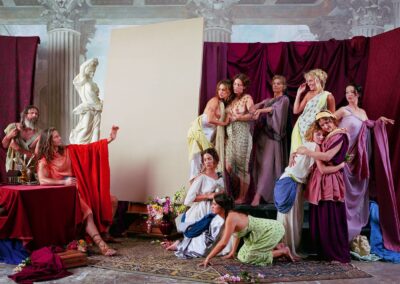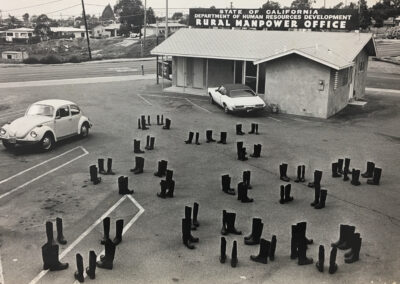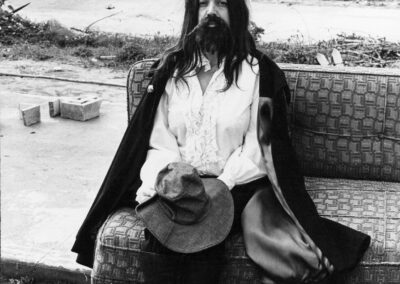Our next Artist You Need To Know is someone who has been praised by no less a controversial figure than Camille Paglia (this is notable, as Paglia has a somewhat dismissive tone, regarding much contemporary art making). From Paglia’s ‘Glittering Images: A Journey through Art from Egypt to Star Wars’: Eleanor Antin “has more than any other American or European artist fulfilled Fluxus’s ambition of bursting the barriers between artistic genres. She has utilized a staggering range of styles, media, and materials, and her work has combined theater, dance, literature, drawing, painting, sculpture, crafts, photography, video, and architecture. “All artworks are conceptual machines,” she said. And again: “All art exists in the mind.” Antin deeply influenced the emergence of both performance art and Conceptual photography.”
-

Judgement of Paris (after Reubens) - Dark/Light Helen
-

The Tourists from Helen's Odyssey, 2007
-

Casting Call, from Roman Allegories, 2007
Another significant cultural voice, in writing about Antin’s conceptual / photographic / performance work ‘100 BOOTS Move On’, 1971 – 1973, Blake Gopnik, offered the following: “For month after month after month, her five-score empty rubber boots had to be carted across the country, set up in various evocative spots, and then photographed before someone could come along and chase Antin away…at the time, the empty boots would have had immediate resonance as a reference to the Vietnam War, and to the boot-wearers who would never come home.”
Since the early 1960s, Eleanor Antin’s art has focused upon history, contemporary culture and the construction and assumptions around identity from a feminist stance. A poet and actress before shifting into visual arts, Antin has employed her experience in theatre (language, character, costume) to expand – and challenge – photography, sculpture and painting. This is, in many ways, her legacy: ‘Her disregard for the boundaries between art, performance, and theater opened possibilities for younger generations of artists working between the studio and the stage.’ (Emily Liebert, from an text for MoMA The Museum of Modern Art )
Antin taught at UC San Diego, from 1975 until 2002, where she was a key activist at the Woman’s Building, a cultural and educational center in Los Angeles.
Some of Antins’ best known works, however, are those she’s made since the early 2000s: her large scale photographic tableaux ‘mine classical history and art history to reflect on current issues such as environmental destruction and modern warfare. These bodies of work, like the ones that precede them, are often marked by wit and humor, even as they engage serious, even dark, matters.’ (Liebert, again)
Eleanor Antin has an extensive CV: her solo exhibitions and group shows are numerous, including Hirshhorn Museum and Sculpture Garden, The Museum of Contemporary Art, the Kunsthalle Wien (Vienna), and documenta 12 in Kassel. Her work is in the permanent collections of The Art Institute of Chicago, Whitney Museum of American Art, the Museum of Modern Art, The Jewish Museum, and the SFMOMA San Francisco Museum of Modern Art.
She was the recipient of a 1997 Guggenheim Fellowship, and her exhibition ‘The Last Days of Pompeii’ was awarded the 2003 International Association of Art Critics award for Best Gallery Show.
Antin has been creating work for nearly six decades, and that simple yet astonishing fact is reflected in how her ‘work gave a platform to a mode of presentation that contradicted gender expectations at the time and surely paved the way for a new generation of artists to interrogate gender norms.’ The groundbreaking – and equally controversial – late author Kathy Acker was a friend, and they shared a sense of ideology and activism (especially considering Antin’s use of mail art, around 100 BOOTS, in a response to how mainstream galleries were not accessible to many female artists at that time). From Daniel Culpan (writing in 2017, for The White Review): ‘By 1973, ‘100 Boots’ found its way to MoMA and – finally – its place in the canon of seminal feminist art, the revolutionary spirit of ‘100 Boots’ ensuring Antin’s legacy: a second-wave feminist who stood her ground and forced her way into the fold.”








